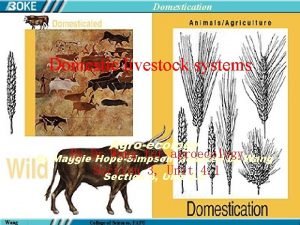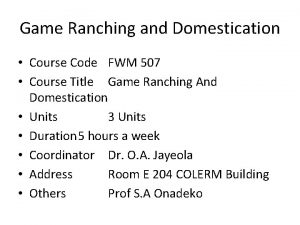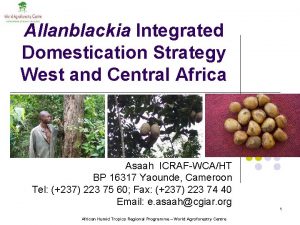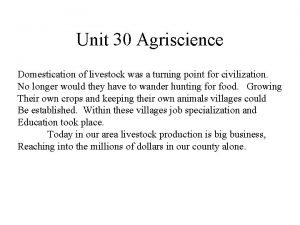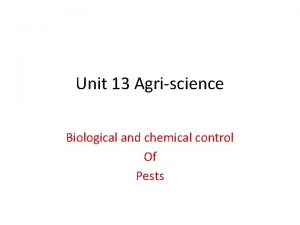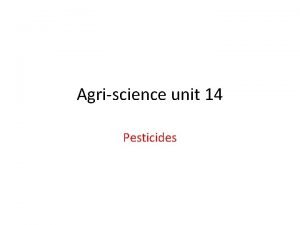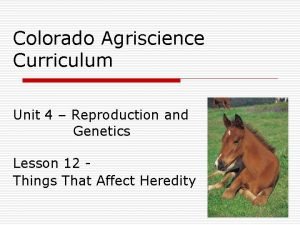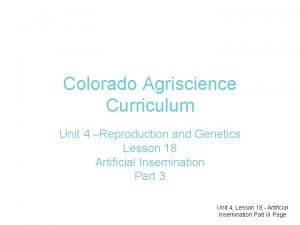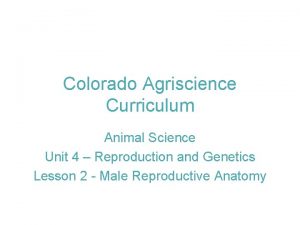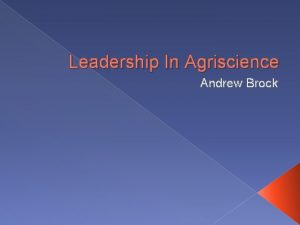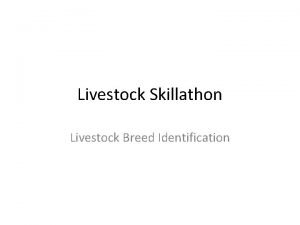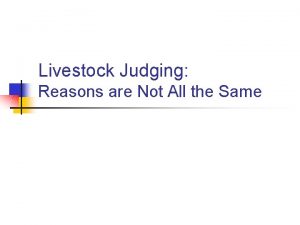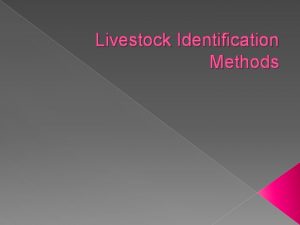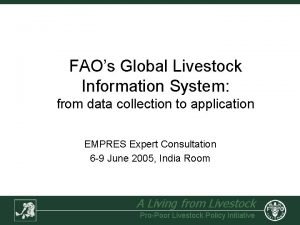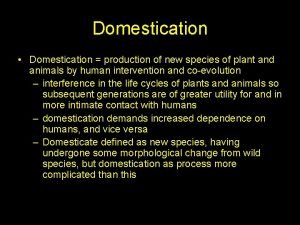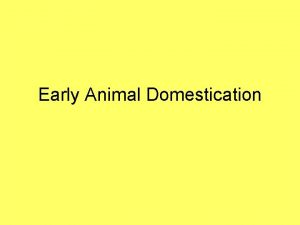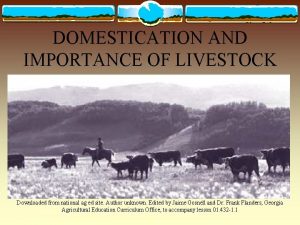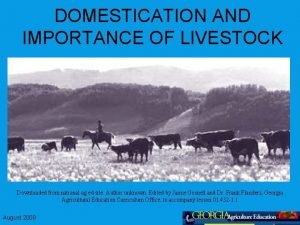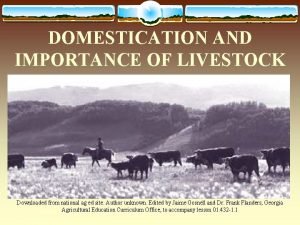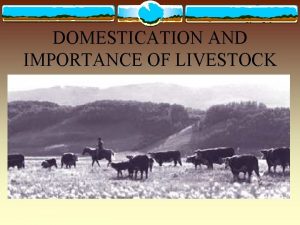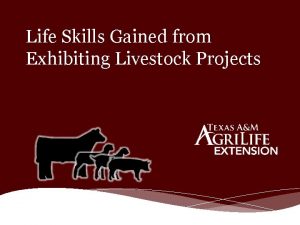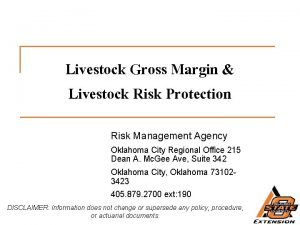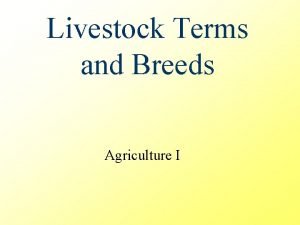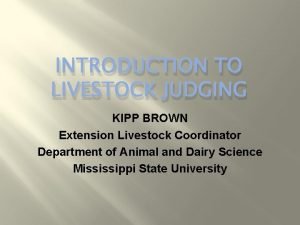Unit 30 Agriscience Domestication of livestock was a
































- Slides: 32

Unit 30 Agriscience Domestication of livestock was a turning point for civilization. No longer would they have to wander hunting for food. Growing Their own crops and keeping their own animals villages could Be established. Within these villages job specialization and Education took place. Today in our area livestock production is big business, Reaching into the millions of dollars in our county alone.

Dairy production Hippocrates the father of modern medicine first wrote about the value Of milk as a food in 400 BC. The First milk cows appeared in North America in 1493 on Columbus Second voyage to the new world. Settlers in Jamestown also brought milk cows with them in 1611.

Economic importance of dairy Dairy business is the second most important animal enterprise in the United States Each American consumes 580 pounds of milk and dairy products Each year. There are 9. 2 million cows in the United States Calves not kept for diary purposes are sold as veal. Mature cows and bulls that are no longer profitable are sold as Beef. Dairies that produce milk for human consumption are Class A dairies. These dairies are very strictly regulated. Dairies that produce milk for use in cheese, butter, and ice cream, are Class B dairies, and are not as strictly regulated.

Breeds Holstein – Ninety percent of all milk cows in the United States are Holsteins. They have the highest average milk production, in pounds, Of all diary breeds

Breeds Jersey – Are the smallest of the dairy breeds. They have the highest butterfat contest in their milk of any Breed. This is important for the makers of butter and ice cream

Breeds Guernsey – Another breed popular in the United States. It produces Milk with yellowish color so it is sometimes called the “Golden Guernsey”.

Breeds Ayrshire Brown Swiss These two breeds are raised in few number then the breeds mentioned before them. What do you know about these breeds?

Approved practices These are some approved practices mentioned in the book. Remember That most dairy calves, whether they are kept or not, are raised off the cow. CALVES Make sure all calves get colostrum, the cows first milk. Feed good milk replacer to all the calves Start the calves on a grain creep feed within ten days. Breed heifers at 20 to 24 months of age COWS Rebreed cows 45 to 60 days after calving Manage for a 60 day dry period before calving again Milk on a regular basis, two (2 X) or three (3 X) a day.

Beef production The first cows that were domesticated were used for meat, milk, as Well as draft, a source of power. First settlers on the east coast of the content used the animals To do plowing and other heavy work that required slow, tough power. Spanish settlers brought the longhorn a tough animal to provide Food for the many Spanish missions in the new world.

Economic importance Beef production is the number one red meat industry in the United States. Each American eats about 96 pounds of beef annually This means the beef industry is a $40 BILLION business annually These animals harvest grass and turn it into a product we can use The by product industry from beef is amazing. It is used in anything From jello to cosmetics. Types of production: Purebred – Provide different genetic material for the calf producer. Cow-calf – produce calves for feedlot operators. Sometimes backgrounders will feed calves out. Feed lot – This is where calves are grown and fattened under controlled Conditions. The animals are slaughtered when they are finished.

Breeds English or Standard breeds. Angus Shorthorn Galloway What do you Know about These breeds? Devon Red Poll

Exotic breeds Imported for leaner meat from dual and tri purpose breeds. Imported after 1973? Charolais Limousin Have you seen These breeds? What do you know About them? Maine Anjou Blond D’ Aquitaine Simmental

American Breeds Bred for heat and disease tolerance Many use Brahman and English breeds Brangus Have you seen any of these breeds in our Area? Can you find out any information On other American breeds? Beefmaster

Practices motioned in the book üSelect a proper breed that will do well in your area. üBe able to judge the merits of individuals visually üBase all of your calf weights on 205 days. üFigure one bull per 25 cows in a range situation üKeep breeding time 30 to 60 days so that calving time i 30 to 60 days.

Swine production The first record of swine domestication was in China in 4900 BC. All breeds can trace there roots to either the European wild pig (Scrofa) Or the Indian wild pig (Vittalus) Swine came to the North American continent in 1493. The second Voyage of Columbus. They were used as food on the ship and on The shore.

Economic importance Second red meat industry in the United States. The swine industry generates $13 BILLION in annual revenues. There are 62 million hogs in the U. S. The U. S. is third in the production of swine. China is first and Russia is second. Each American annually eats 62 pounds of pork (the meat from swine). Hogs one of the best feed conversion rates of any farm animal. It Takes only 3. 5 pounds of feed to produce one pound of gain.

Types of swine operations Feeder pig – Produce hogs for market hog operations. Sows are Managed to have two to two and one half litters per year. Market hog – Feed out piglets. They usually buy animals 5 -8 weeks Of age, 40 pounds, and feed them until they weigh 240 -260 pounds. The animals are slaughtered. Purebred – Supply feeder operations with new and improved genetic Material in the form of Bores and gilts.

Swine Breeds U. S. importance Duroc Polandchina Hampshire Chester White Have you seen any of These breeds in our County? Why aren’t there any hog Producers in our county? Spotted Polandchina Or Spotted hog.

Swine Breeds European Yorkshire Berkshire Tamworth

Swine breeds others American Landrace – developed in Denmark

Approved practices ØBuy good hogs to start any operation ØWatch for disease, it can wipe out a swine operation very quickly ØFormulate rations for each stage of development ØBreed gilts, young female hogs, at 8 months of age. ØClip teeth, ear notch, castrate, and vaccinate at an early Øage so you don’t set them back. ØRebred sows at first estrus after farrowing ØWean piglets at 4 to six weeks of age

Sheep production Sheep have been domesticated for over 20, 000 year. Sheep can be used for meat(mutton), wool, pelts, and milk Sheep also came to North America in 1493 with Columbus.

Economic importance Americans eat 1. 7 pounds of lamb annually and use about. 8 pounds Of wool. Lamb and Mutton is a very ethnic food. There are 7. 8 million sheep in the United States. The sheep industry creates $70 million dollars in revenue every year Types of operations Farm flocks – Usually considered less than 150 head. Mostly purebred And account for one third of the sheep in the U. S. Range – eleven million sheep are raised in open range conditions, this Accounts for two thirds of all the sheep in the U. S.

Sheep breeds fine wool Delaine merino, American merino All decedents of the Spanish merino Debouillet What does FINE wool Mean? Rambouillet

Suffolk Hampshire Sheep breeds medium wool Shropshire What do you know About sheep with Black fibers in their Wool? Dorset Southdown

Sheep breeds Long wool Leichester Lincoln Why would any Producer want To have a sheep With LONG Wool origins? Cotswold Romney

Approved Practices v. Be able to select superior livestock v. Vaccinate for diseases and parasites in your area v. Breed ewe lambs to lamb the first time at 2 years of age v. Try to sear before lambing v. Dock and castrate early

Goat Production Goats have been domesticated since 7, 000 to 3, 000 BC. They may Have been domesticated about the same time as sheep. Early colonists in North America imported goats from Switzerland. Goats can be used for meat (chevon), milk, dairy, and mohair (hair) production

Economic importance Goat production is low in economic importance as most flocks Are small privately owned non-commercial. Sixty percent of the mohair production in the world comes from The United States, most of that is produced in Texas.

Breeds of goats hair producing Angora What else are angora used for locally?

Milking Breeds of goats Nubian Saanen Alpine Do you know of any infants that may Have had to drink goats milk, why? Does goats milk have more or less Cream than cows milk? Toggenburg These goats produce 3 -4 quarts of milk Per day.

Approved Practices §Select the breed of goat for the use and the area §Feed milking goats grain because of production §Figure one buck for 20 to 50 does depending on The pasture size and age.
 Domestication
Domestication Domestication of animals
Domestication of animals Domestication
Domestication Domestication
Domestication On the different methods of translating schleiermacher
On the different methods of translating schleiermacher Livestock breed identification: swine - vocabulary
Livestock breed identification: swine - vocabulary Teks anatomy and physiology
Teks anatomy and physiology Agriscience unit 13 completion answers
Agriscience unit 13 completion answers Unit 6 leadership development in agriscience
Unit 6 leadership development in agriscience Agriscience unit 14 completion answers
Agriscience unit 14 completion answers Unit 2 better living through agriscience
Unit 2 better living through agriscience What is agriscience
What is agriscience Colorado agriscience curriculum
Colorado agriscience curriculum Colorado agriscience curriculum
Colorado agriscience curriculum Colorado agriscience curriculum
Colorado agriscience curriculum Colorado agriscience curriculum
Colorado agriscience curriculum Project conclusion example
Project conclusion example Definition of agriscience
Definition of agriscience Colorado animal science curriculum
Colorado animal science curriculum Agriscience applications
Agriscience applications Define agriscience
Define agriscience Animal systems agriscience project ideas
Animal systems agriscience project ideas Unit 1 careers
Unit 1 careers Colorado ag curriculum
Colorado ag curriculum Ffa agriscience fair ideas
Ffa agriscience fair ideas Livestock breed identification swine - assessment
Livestock breed identification swine - assessment Cattle egrets and livestock
Cattle egrets and livestock Livestock judging oral reasons
Livestock judging oral reasons Livestock judging reasons
Livestock judging reasons Livestock risk management brokers near me
Livestock risk management brokers near me Livestock classification chart
Livestock classification chart Livestock identification methods
Livestock identification methods Livestock information system
Livestock information system

